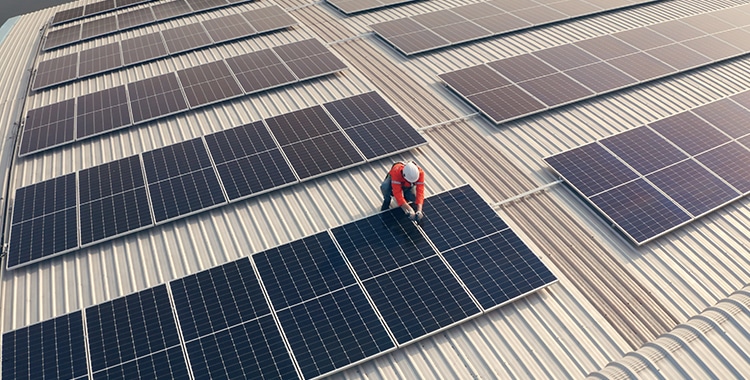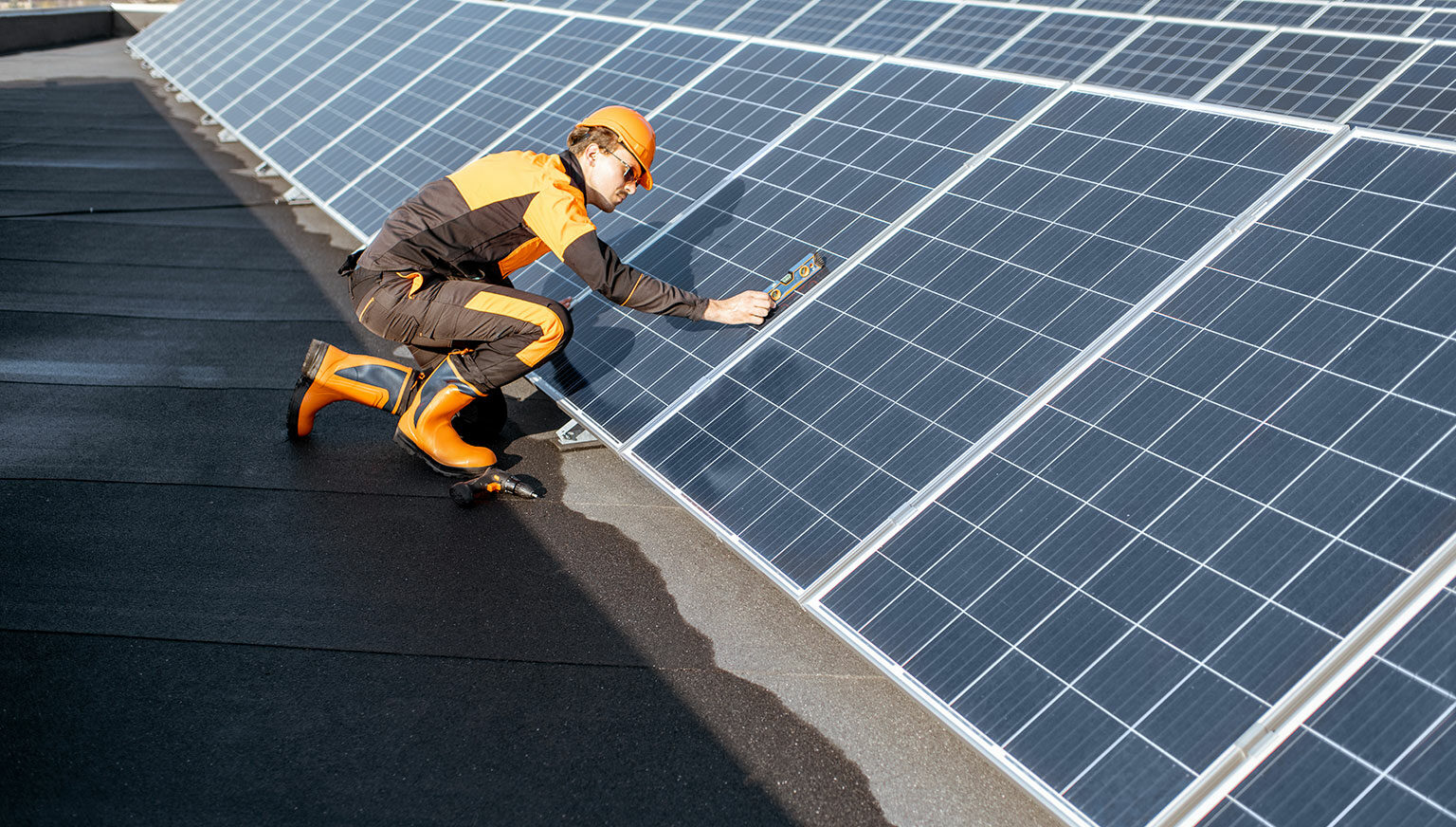Let’s start with a short answer to the question posed in the title. The optimal solar panel tilt angle is the one that allows for capturing the maximum amount of sunlight throughout the year.
In this article, we will:
- Explore the range of possible tilt angles for solar panels.
- Analyze key factors that influence the choice of the optimal tilt angle.
- Discuss revolutionary solar tracking technology.
- Share useful links with additional resources on designing and building photovoltaic systems.
- Explain how solar panel direction and angle affect efficiency and energy production.
Solar Panel Tilt Angle: Let’s Explore the Possible Options
Photovoltaic panels can be set at the following angles:
0° Angle (Flat Roofs)
- This is a method of installing photovoltaic systems on flat roofs of buildings, although it is not very commonly used.
- In this case, sunlight hits the panels at a sharp angle, especially in the morning and afternoon, which reduces the amount of energy they can capture.
- This angle is not used for ground installations— the appropriate solar panel tilt angle for ground-mounted systems is greater to facilitate rainwater drainage and minimize shading.

Tilt Angles: So-Called Low Angles of About 10° to 20° (Climate of Andalusia)
- This tilt angle for photovoltaic modules is most common in countries with a warm climate, where the sun is high in the sky for most of the year (e.g., southern Spain, Greece, United Arab Emirates).
- Lower angles can help with better cooling of the panels, which increases their efficiency—this is significant in regions with high temperatures.
- A low solar panel tilt angle may be desirable in areas where strong winds occur; a panel tilted this way has a smaller surface directly exposed to the wind.
The Ideal Solar Panel Tilt Angle in Poland: An Average Angle of About 30° to 40°
- This angle allows for good energy production throughout the year in Poland and regions with a similar climate—providing a good balance between energy production in summer and winter.
- The ideal solar panel tilt angle is always dependent on local conditions, so we cannot assume one perfect option for all locations in Poland.
- In winter, this tilt angle for photovoltaic panels helps with natural cleaning of snow and debris.

Innovations: Adjusting the Tilt Angle of Solar Panels
In the case of more advanced photovoltaic installations, solar tracking systems can be used to automatically adjust the tilt angle of the panels throughout the day to maximize exposure to the sun.
At Electrum, we implement such projects. Read more about it:
Another Innovative Project Completed by Electrum – PV Kotuń with Solar Tracker Technology
How do solar trackers work?
Solar trackers allow for adjusting the tilt angle of the panels. With their help, it is possible to significantly increase the efficiency of photovoltaic panels and energy production.
Solar trackers follow the movement of the sun in the sky, adjusting the tilt angle of the panels in real time. They can rotate the panels both horizontally and vertically, allowing for optimal positioning throughout the day.
High Angle of About 50° to 60° (e.g., Scandinavian Countries)
- This panel positioning is used in areas with low sunlight or to maximize efficiency in winter.
- It is the optimal tilt angle for photovoltaic panels in many mountainous regions with a cool climate and where the sun shines low on the horizon during the winter months.
- A high tilt angle for photovoltaic panels allows for easier snow sliding and water drainage.

90° Angle (Vertical Installations)
- This is a rarely used solution that can be found in architectural installations where panels are mounted vertically.
- It provides the opportunity to collect light in specific conditions, such as on building facades.

Choosing the best solar panel tilt angle: Location and Season
A detailed answer to the question of what is the best tilt angle for photovoltaic panels depends on several key factors.
During the design phase of a photovoltaic installation, we analyze all relevant factors and adjust the tilt angle of the panels to the specific project.
If you want to know more about designing photovoltaic farms, read:
The analysis includes, among other things:
- Location of the photovoltaic installation – geographical latitude, which affects the position of the sun in the sky (Also read: How to Choose the Best Location for Solar Panels?),
- Season – the efficiency of the panels in winter can be increased by modifying the tilt angles of the modules,
- Type of structure – depending on the installation method (on a roof, on the ground, on a frame structure), the ideal tilt angle of the panels may vary,
- Purpose of the PV installation – if the photovoltaic system aims to maximize energy production in summer or winter, the tilt angle can be adjusted accordingly,
- Shading – if there are tall buildings, trees, or other obstacles nearby, the tilt angle can be adjusted to avoid shading the panels.
Another Important Matter: Solar panel direction
Solar panel direction, or in other words, the orientation of the photovoltaic panels, refers to the direction in which the panels are set concerning the horizon.
The orientation of solar photovoltaic panels, like the tilt angle, is crucial for maximizing energy production from the installation.
Southern direction
Panels facing south are a common solution in the Northern Hemisphere (including Poland). They provide the greatest exposure to sunlight throughout the day, resulting in higher energy production.
Eastern and Western direction
If southern orientation is not possible, eastern or western orientation can also be effective. Panels facing east will produce the most energy in the morning, while panels facing west will be more efficient in the afternoon.
Northern direction
In countries located closer to the equator, where the sun is high in the sky, northern orientation may be used (for example, to avoid overheating of the panels).
However, this type of module orientation is not a standard solution.
What is the best solar panel tilt angle? Summary
Finding the optimal solar panel tilt angle is a key element in designing an installation. The angle of sunlight incidence varies across different regions of the world, and adjusting the tilt of the panels and selecting the angle allows for optimizing the performance of a photovoltaic power plant.
The possible tilt angle of the panels ranges from 0° to 90°. The optimal tilt value for panels in Poland usually ranges from 30° to 40°. Proper positioning increases the efficiency of photovoltaic panels and, consequently, your profits.
If you need a trusted partner for the design and construction of photovoltaic installations, we invite you to: Contact
And if you want to learn more about how we build large-scale photovoltaic farms, check here:

